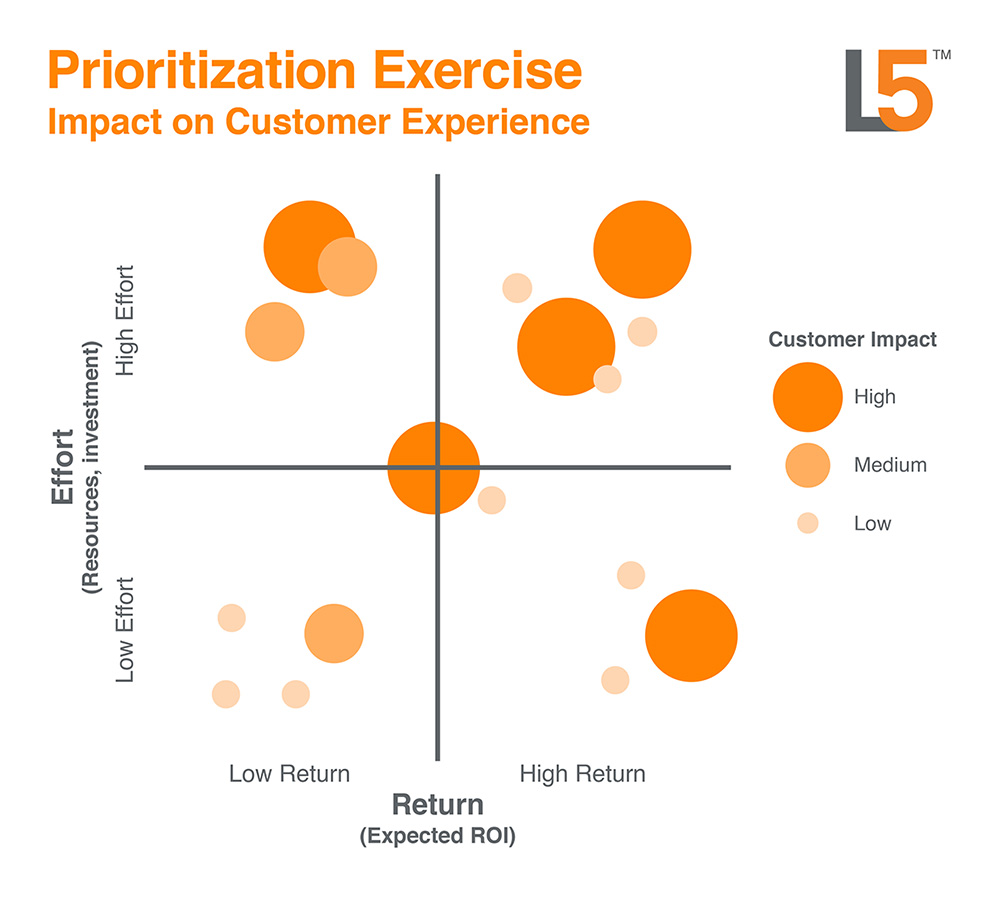
Operationalizing Customer Experience: Four Important Steps to Translate Customer Journey Mapping into Tangible, Actionable Initiatives
March 1, 2023
When building a best-in-class customer experience, understanding the customer journey and identifying opportunities to improve at Moments of Truth is just the beginning. Organizations must translate journey insights into actionable initiatives to deliver meaningful returns on their investments.
Missed the first article in this series about key pain points? Check it out here.
How should organizations think about leveraging journey maps and CX insights to develop strategic initiatives that drive ROI?
In our experience advising organizations across industries to deliver best-in-class customer experiences we have identified several trends related to companies’ customer-centric maturity. Companies we work with undergo a four-step process: analyze, ideate, prioritize, and execute.
Step 1 – Analyze
The first step an organization must take is to analyze the customer journey through the lens of available data. This means that a company should identify all possible sources of data that are available to support the analysis of the customer experience pain points and moments of truth. These journey focal points are surfaced during the research phase of a customer journey mapping process and indicate areas of possible tension within a customer’s journey that a company may seek to reduce through future journey improve initiatives and projects.
No matter how limited access to data may be, organizations should compile as many internal data sources related to the customer journey as possible, to validate the insights uncovered during the journey mapping process.
Level5 works with clients through a process of analyzing and validating pain points and moments of truth at three levels: experience, process, and technology. Data on its own can be confusing – we use these three lenses to drill down to the root cause of a pain point and identify the underlying mechanisms or gaps that cause the pain point to repeatedly occur. It is likely that a handful of root causes appear many times. This list of root causes are often major organizational or technological challenges that a business is facing. Executives should focus resources toward solving these deeper underlying problems to enable their teams to solve the customer-facing pain points closer to the surface.
Through this process of analysis and validation customer experience practitioners can develop a better understanding of which moments of truth and pain points are causing the most problems for both customers and the business. Reporting on these data-backed journey insights will allow executives to make more informed decisions in the later steps of this process.
Step 2 – Ideate
Once the major journey pain points have been identified and validated with data, an organization must turn its attention to generating potential solutions. At this time, and applying the lens of the core customer need, the team can decide whether a net new process would better deliver on a customer need, or if incremental improvements are the correct course of action.
The ideation phase should involve subject matter experts across a variety of functions and departments within the company. Engaging a cross-functional team in the process allows for more creative solutions to be generated while also having the additional benefit of elevating the importance of customer experience within the organization and breaking down silos that may exist between different departments and functions.
Our clients frequently gain substantial internal benefits when using cross-functional teams in this part of the process, and it is a key feature in our customer experience engagements.
The objective for the team at this stage in the process is to examine the insights from the analysis in the previous stage and ideate possible solutions to customer pain points or suggest ways to improve the journey at moments of truth.
At this point, there should be no evaluation of the suggestions, only categorization, the purpose here is to fill the top of the funnel with as many viable journey improvement ideas as possible, categorized in a way that the team sees fit – whether these are net-new processes, or improvements to existing ones
Examples may be to categorize the ideas into improvements to process, people, or technology; or to bucket solutions by engagement channel (e.g., website/online, physical/in-person, phone, mobile app, etc.). This categorization allows for more effective prioritization in the next stage.
Step 3 – Prioritize
Once the working team has generated enough improvement initiatives to solve customer problems and enhance the experience, prioritization becomes the focus.
A simple and effective process for prioritization is to evaluate initiatives in terms of effort (i.e., resources, investment, etc.) vs. return (i.e., expected ROI).
However, this approach fails to take the customer into consideration. An effective modification to this approach is to first score each initiative on a 3-point scale for how much impact the initiative will have on the customer experience.

This prioritization exercise is a great way to align team members and executives on what is strategically important and will drive both returns and high impact to customer experience.
Step 4 – Execute
Once priorities are set and alignment is achieved, it is time to operationalize the plan. Effective action plans map initiatives, are cross-functional, hold people accountable, and are flexible.
Mapping initiatives: executing means turning solutions sets and concepts into initiatives that translate to annual strategic planning and the operational cycle.
Cross-functionality: assign individuals from different business functions as responsible for the successful implementation of an initiative. This ensures that a diverse group of voices are in the room, and that the team can solve problems in an agile manner, eliminating the need for follow-up meetings with different departments every time something needs to be approved.
Accountability measures: ensure a mechanism in is place to keep team members on track. This will drive initiatives forward more quickly and make sure everyone is on board.
Flexibility: as things change, so must the business. Any effective plan must take changing consumer expectations, market projections and more into account as it moves forward.
Does your organization need a tangible, actionable plan to drive customer experience initiatives forward? Contact Laura Richard or Joseph Smith.



